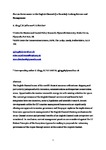Marine governance in the English Channel (La Manche): Linking science and management.
| dc.contributor.author | Glegg, Gillian | |
| dc.contributor.author | Jefferson, R | |
| dc.contributor.author | Fletcher, S | |
| dc.date.accessioned | 2015-10-20T09:31:40Z | |
| dc.date.available | 2015-10-20T09:31:40Z | |
| dc.date.issued | 2015-06-30 | |
| dc.identifier.issn | 0025-326X | |
| dc.identifier.issn | 1879-3363 | |
| dc.identifier.uri | http://hdl.handle.net/10026.1/3662 | |
| dc.description.abstract |
The English Channel is one of the world's busiest sea areas with intense shipping and port activity juxtaposed with recreation, communications and important conservation areas. Opportunities for marine renewable energy vie with existing activities for space. The current governance of the English Channel is reviewed and found to lack integration between countries, sectors, legislation and scientific research. Recent developments within the EU's marine management frameworks are significantly altering our approach to marine governance and this paper explores the implications of these new approaches to management of the English Channel. Existing mechanisms for cross-Channel science and potential benefits of an English Channel scale perspective are considered. In conclusion, current management practices are considered against the 12 Malawi Principles of the ecosystem approach resulting in proposals for enhancing governance of the region through science at the scale of the English Channel. | |
| dc.format.extent | 707-718 | |
| dc.format.medium | Print-Electronic | |
| dc.language | en | |
| dc.language.iso | en | |
| dc.publisher | Elsevier BV | |
| dc.subject | Ecosystem approach | |
| dc.subject | English Channel | |
| dc.subject | Governance | |
| dc.subject | Integration | |
| dc.subject | Marine | |
| dc.subject | Marine spatial planning | |
| dc.subject | Conservation of Natural Resources | |
| dc.subject | Ecosystem | |
| dc.subject | Environmental Policy | |
| dc.subject | France | |
| dc.subject | Government | |
| dc.subject | Renewable Energy | |
| dc.subject | Science | |
| dc.subject | Ships | |
| dc.title | Marine governance in the English Channel (La Manche): Linking science and management. | |
| dc.type | journal-article | |
| dc.type | Journal Article | |
| dc.type | Research Support, Non-U.S. Gov't | |
| plymouth.author-url | http://www.ncbi.nlm.nih.gov/pubmed/25819447 | |
| plymouth.issue | 2 | |
| plymouth.volume | 95 | |
| plymouth.publication-status | Published | |
| plymouth.journal | Mar Pollut Bull | |
| dc.identifier.doi | 10.1016/j.marpolbul.2015.02.020 | |
| plymouth.organisational-group | /Plymouth | |
| plymouth.organisational-group | /Plymouth/Faculty of Science and Engineering | |
| plymouth.organisational-group | /Plymouth/Faculty of Science and Engineering/School of Biological and Marine Sciences | |
| plymouth.organisational-group | /Plymouth/REF 2021 Researchers by UoA | |
| plymouth.organisational-group | /Plymouth/REF 2021 Researchers by UoA/UoA14 Geography and Environmental Studies | |
| plymouth.organisational-group | /Plymouth/Research Groups | |
| plymouth.organisational-group | /Plymouth/Research Groups/Marine Institute | |
| plymouth.organisational-group | /Plymouth/Users by role | |
| plymouth.organisational-group | /Plymouth/Users by role/Academics | |
| dc.publisher.place | England | |
| dcterms.dateAccepted | 2015-03-26 | |
| dc.rights.embargodate | 2016-3-26 | |
| dc.identifier.eissn | 1879-3363 | |
| dc.rights.embargoperiod | No embargo | |
| rioxxterms.versionofrecord | 10.1016/j.marpolbul.2015.02.020 | |
| rioxxterms.licenseref.uri | http://www.rioxx.net/licenses/all-rights-reserved | |
| rioxxterms.licenseref.startdate | 2015-06-30 | |
| rioxxterms.type | Journal Article/Review |


